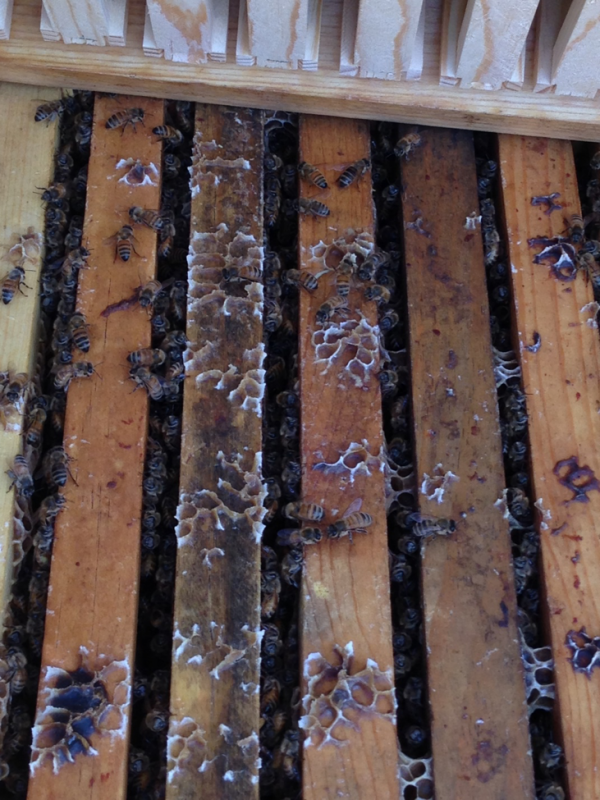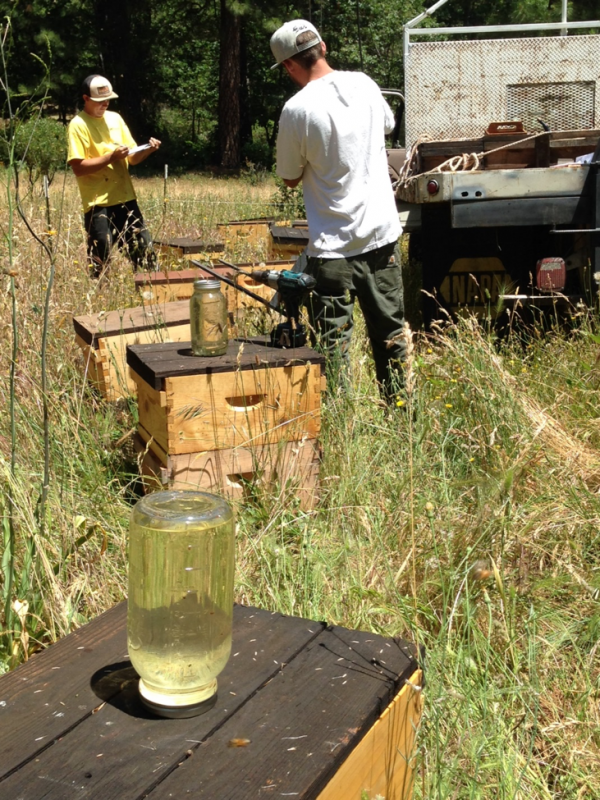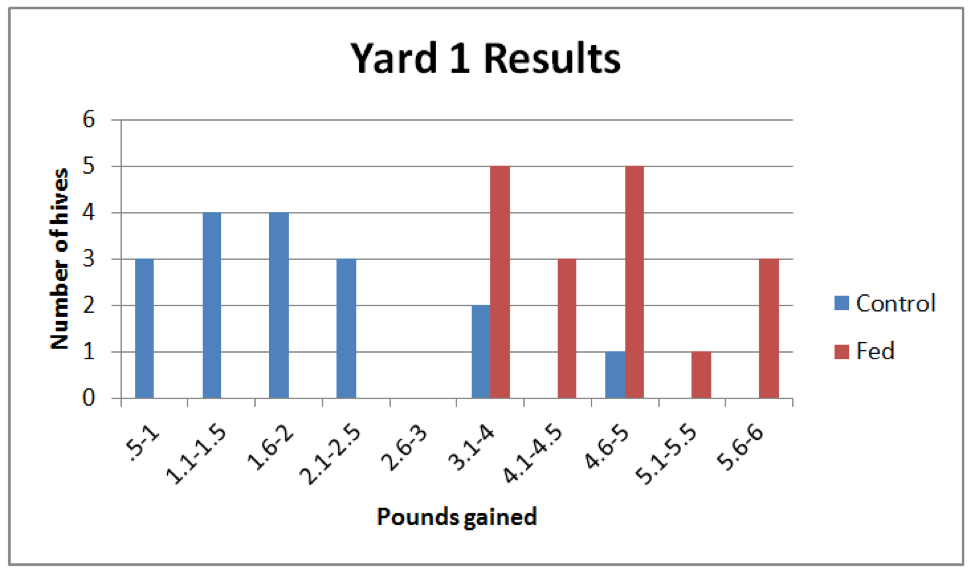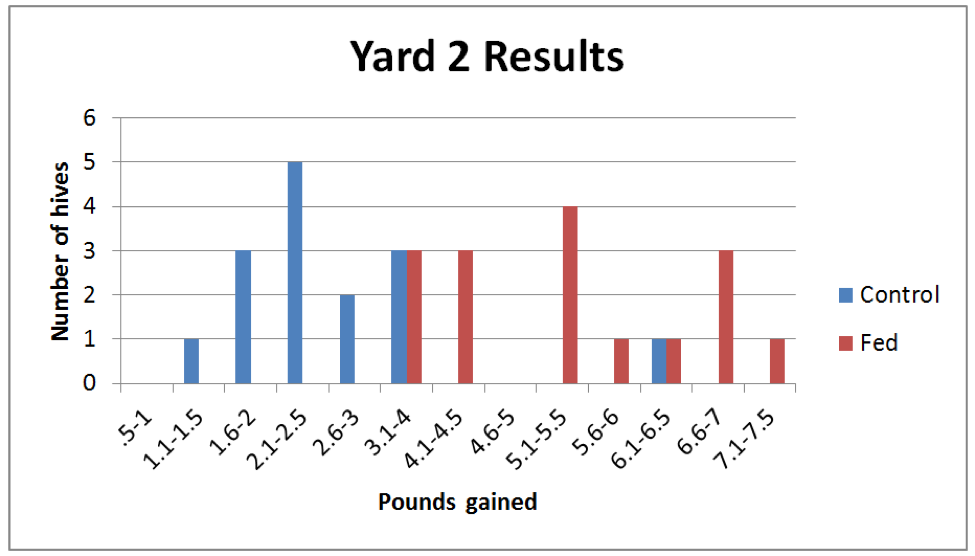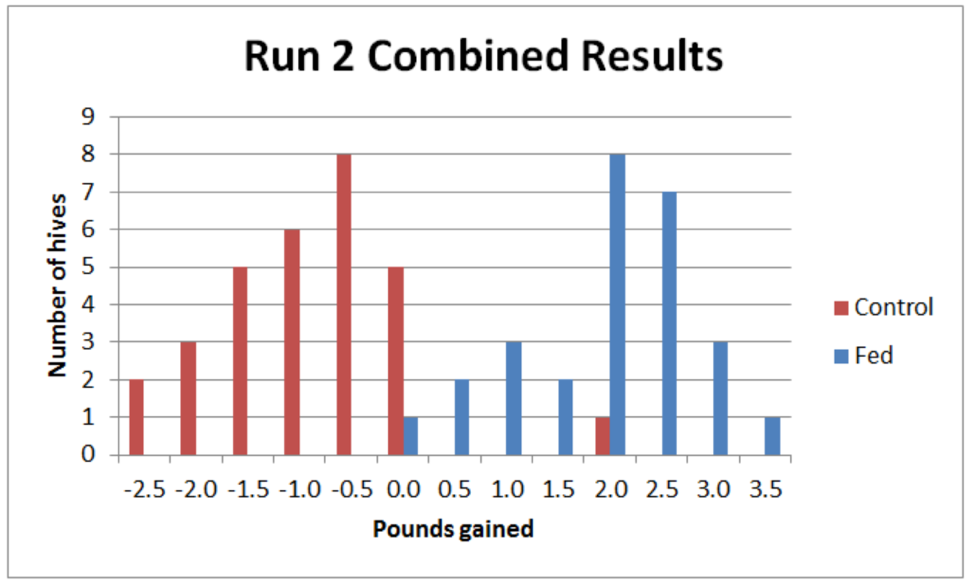Is There A Multiplier Effect From The Feeding Of Sugar Syrup?
Is There a Multiplier Effect from the Feeding of Sugar Syrup?
Randy Oliver
ScientificBeekeeping.com
First published in ABJ August 2016
I ran a few hundred hives for many years without feeding a drop of sugar syrup, due to my feeling that it was “unnatural.” In later years, as I questioned my idealistic notions, I found that my colonies actually responded quite favorably to supplemental feeding with syrup. And sometimes, giving a building colony a shot of syrup seems to work miracles.
Beekeeping’s Gotten Tougher
After we bring our hives back from almond pollination, we split them all, leaving each nuc with a comb of honey. Historically, that was all they needed, as Nature would then provide an adequate supply of nectar (other than during a brief dearth following apple bloom) clear until the honey flow, thus allowing the colonies to grow on natural forage alone. This is no longer the case, hardly a surprise during California’s worst drought in 500 years.
Beekeeping today is tougher than it used to be. In my area, I can’t blame it on pesticides, since there are very few applications in my county. Nor can I blame it completely on varroa, since we generally do a fair job of keeping the mite under control. What I do see, however, is a change in plant distribution, phenology of bloom, and output of nectar in response to drought and climate change in my arid environment.
Our winters today are shorter (and thus our summer drought is longer), the sequence of plant bloom runs up to three weeks earlier than it did in my early records, and formerly reliable blooms may now not produce any nectar. Whereas I used to be able to depend upon Mother Nature to provide for my bees, I now find that I must sometimes step in with supplemental or stimulatory feeding.
A “Multiplier Effect”?
Feeding our 1500 hives is expensive and laborious, and since honey does not provide our main income, I look closely at our return on investment from feeding. What I’ve noted time and again, is that giving lagging colonies a jar of syrup would immediately turn them around, and that they seemed to suddenly gain weight in excess of that which would be expected from the weight of the syrup alone. I rationalized this observation in my mind by hypothesizing that the syrup stimulated the foragers to go out and seek additional nectar sources, thus creating a “multiplier effect”—that is, by feeding a pound of syrup, that the hive would gain more than a pound of weight. If this were indeed the case, it would make syrup feeding an even better return on investment.
I always keep in mind, however, that the easiest person to fool is always yourself. The question that every beekeeper should ask himself when he’s come up with a beautiful explanation (which gains credibility with each telling), is whether he’s fooling himself. Thus, I decided to put my hypothesis to a rigorous test by collecting actual data.
A Controlled Experiment
The Observation: That when I heft colonies to which I’ve fed a jar of sugar syrup, they appear to quickly gain more weight than that of the added syrup alone.
The Hypothesis: That there is a “multiplier effect” from the stimulation of fresh syrup that causes the foragers to seek out more nectar than they would have otherwise.
Experimental design: in a yard of growing splits, weigh each hive. Randomly assign treatment to half the hives. Feed the “Fed” group a jar of syrup, and give nothing to the Control group. After a few days, weigh each hive again to see whether there was weight gain in the Fed group in excess of that expected due to the amount of sugar in the fed syrup. Simultaneously replicate the experiment in an additional yard.
We started the experiment on June 3, 2015, in a yard of growing splits that had filled their first brood chamber, and to which we had just added a box of foundation. A light nectar flow was on, and the colonies were producing white wax (Fig. 1).
Figure 1. A typical hive at the start of the experiment—filled with nectar below, a box of foundation above. The colony is producing white wax from a natural nectar flow. Would the feeding of a half gallon of syrup increase weight gain above that of the syrup alone?
We weighed each hive with a digital crane scale hung from our hive loader (Fig. 2).
Figure 2. My son Eric weighing hives (I took the picture while holding a rope to take the bounce out of the boom). We followed him by placing jars of syrup on half the hives (randomly assigned by the flip of a coin).
Any experiment should be replicated at least once, so we did the same in another yard (Fig. 3). There were 33 hives in the first yard, 36 in the second.
Figure 3. Eric and Ian are seasoned field researchers, meticulous at following protocols and data collection.
The Math
We used a commercial sucrose/HFCS mix (77% sugar) diluted by one quarter with water (to 61% sugar) and gave a half a gallon to each Fed colony. Each colony in the Fed group thus received approximately 3.18 lbs of sugar, which if converted to 83% sugar content honey, would be expected to increase colony weight by an amount less than 3.83 lbs, since some percentage of that sugar would likely be used metabolically or in the production of wax (Table 1).
 Most of the syrup jars were consumed within 2 days. We allowed the bees a full 6 days to consume the syrup and display any short-term weight gain from the stimulation from feeding, reweighing them on June 9 (6 days after feeding).
Most of the syrup jars were consumed within 2 days. We allowed the bees a full 6 days to consume the syrup and display any short-term weight gain from the stimulation from feeding, reweighing them on June 9 (6 days after feeding).
Results
As would be expected, weight gain per hive followed a normal distribution; most of the Fed hives gaining more weight than the Control hives (Fig. 4).
Figure 4. Histograms of weight gain. The red Fed hives, as expected, tended to gain more weight than the Control hives—but was it more than that expected from the weight of the syrup? Note that each yard happened to contain one exceptional Control colony that put on honey far above the norm.
By adding the maximum expected gain from the syrup (3.8 lbs) to the mean weight gain of the Control groups (2.2 lbs), we arrive at a figure for weight gain of 6.0 lbs that the Fed group would need to achieve in order to support the hypothesis that there was a multiplier effect from the feeding of syrup. In neither yard was there indication of a multiplier effect. For the combined data (Table 2), mean weight gain of the Fed groups was only 4.4 lbs, compared to the expected gain of up to 6.0 lbs.
 We were really surprised by the results, and it bugged us so much that we decided to repeat the trial a second time, when there was no natural nectar flow on.
We were really surprised by the results, and it bugged us so much that we decided to repeat the trial a second time, when there was no natural nectar flow on.
Run 2
We waited until 15 September, by which time it was bone dry due to our drought, foragers were bringing in scant nectar, and colonies were losing weight. We ran the experiment in the same yards, with the same hives, after removing any high-varroa hives to another yard (for a mite-treatment experiment). That left 22 hives in the first yard, 35 in the second. We reversed the Fed and Control hives for this replicate. Weather was cool on weighing day, so we waited until 17 Sept to feed (to ensure good flight weather during the trial), and took final weights on 23 Sept.
Again, the results (Fig. 5, Table 3) did not support the hypothesis that the feeding of a jar of syrup during dearth would encourage the colony to put on more weight than that expected from the syrup alone.
Figure 5. Again, note that in each group there was an outstanding colony that gained weight far above the average.
Table 3. Again, no evidence that there was a multiplier effect from the feeding of syrup, this time during dearth.
An observation: note that in both runs, that there appeared to be a substantial cost to the conversion of 1:1 sugar syrup into stored “honey.” It took the feeding of roughly 3 lbs of sugar in 1:1 syrup to produce a weight gain (adjusted for sugar content only) of 2 lbs.
Discussion
The results bring to mind the famous quote from Thomas Huxley:
The great tragedy of Science — the slaying of a beautiful hypothesis by an ugly fact.
In this case my beautiful hypothesis was slain by a whole pile of ugly data. And yet I still have a hard time letting it go. This spring, we time and again remarked on the miraculous turnaround of splits when given a jar or two of syrup. But that miracle appeared to be purely due to the benefit from the added syrup alone—not from causing increased foraging by the workers. As reluctant as I am to wave goodbye, I must allow my lovely explanation to drop into the dustbin of refuted hypotheses.
That said, although there was no immediate multiplier effect on weight gain from the feeding of a jar of syrup, that in no way detracts from the fact that the feeding of syrup can be of immense benefit to a growing colony. This spring especially, when several of our normal spring nectar flows completely failed, we found that the feeding of even a half gallon of syrup made all the difference in the world to our nucs. It allowed stalled colonies to reinitiate full brood production and comb drawing, thus maintaining their momentum of buildup. When the next nectar flow then commenced, the previously-fed nucs were in much better shape to take advantage of it than those not given syrup.
Practical application: feeding syrup can be of immense benefit to growing colonies, but it does not appear to result in immediate weight gain in excess of that from the syrup alone. We still don’t feed any more syrup than we need to, but find it to be one of the most cost effective tools at our disposal.




